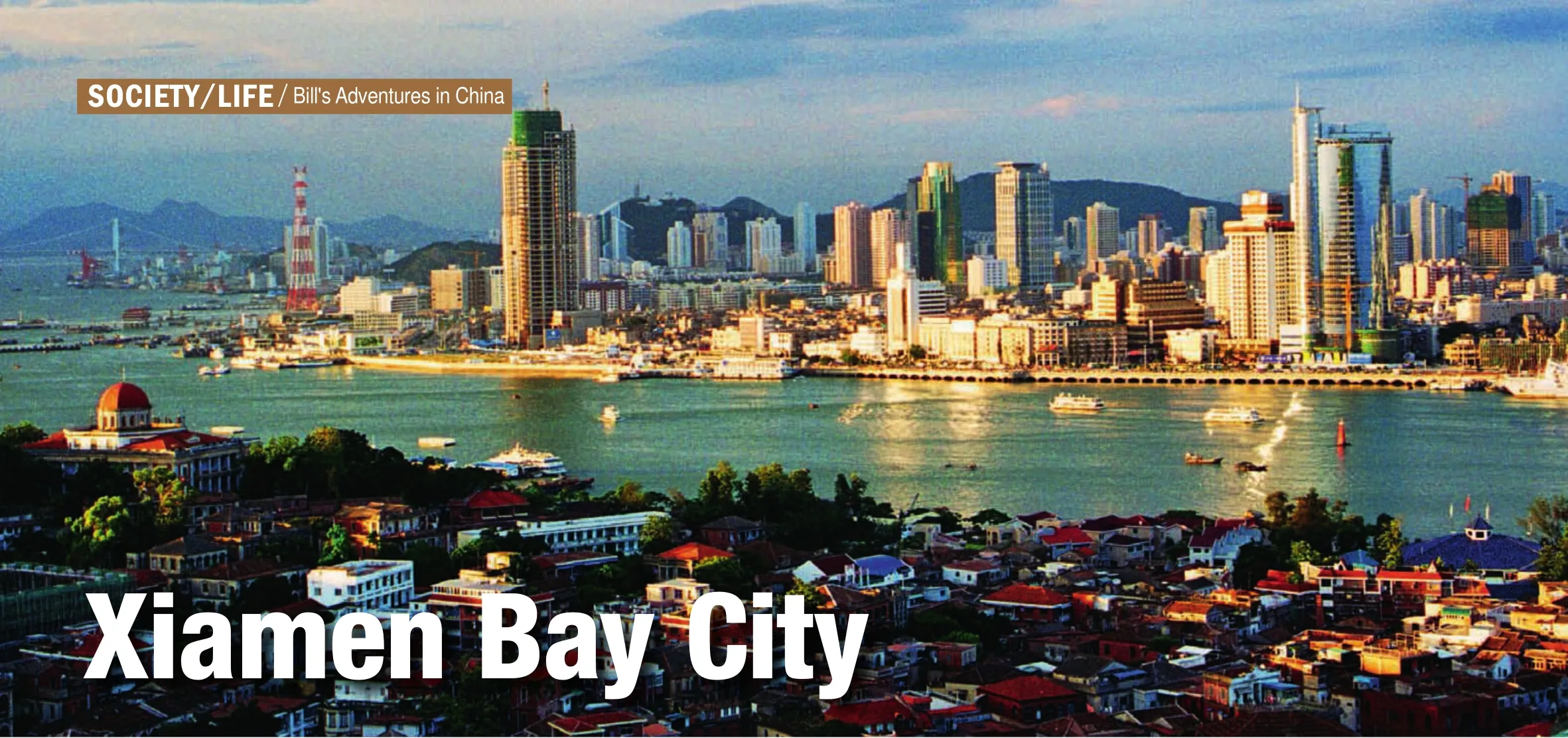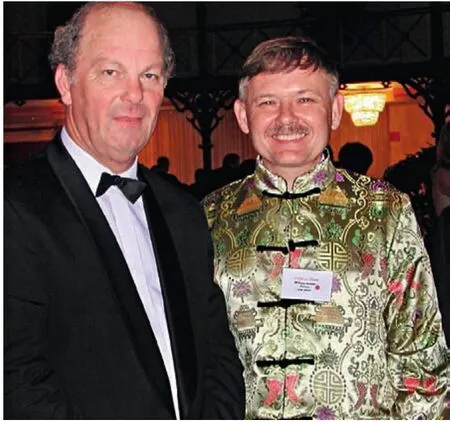Xiamen Bay City
By BILL BROWN
Xiamen Bay City
By BILL BROWN

A panorama of Xiamen City.
T HOUGH I was only 32 when I m oved to Xiam en (for -merly Amoy) in 1988, I had already lived in over 30 cities, and had no intention of staying in Xiamen longer than a year or two. I never imagined our family would still be here 28 years later. While I still love to travel, and each year visit cities around China and the rest of the world, I’ve come to realize that although many places are nice for a visit, there really is no place like home, especially if that home is Xiamen.
I did not come to that decision easily. It is hard for an inveterate wanderer to settle down, so I explored the rest of China, just to be sure. In 1994, my family and I drove more than 40,000 kilometers in our van around China, from Xiamen up the coast to Beijing and Inner Mongolia, through the Gobi desert to Tibet Autonomous Region, and back to Xiamen via southern China. We were amazed at the sheer scope and variety of China’s natural beauty, and the friendliness and hospitality we experienced throughout the country. But nowhere compared with Xiamen as a place to live and work.
Xiamen’s most obvious attraction is of course its natural beauty. For centuries, foreign visitors have been enchanted with its green hills, rocky granite crags, which many compare with Scotland, serene gardens, and picturesque beaches. My wife and I certainly appreciate the island’s beauty. We stroll along the boardwalk each morning, taking in the bracing sea air as we admire the beauty of Xiamen Bay, while observing the massive merchant ships, sampans and junks, and also yachts afloat on it.

A cartoon of Bill riding a bicycle on the Amoy Circular Road.
Today, Xiamen retains its enchanting 19th-century charm as it evolves into a modern city where life is almost like a vacation.

In 2004, Xiamen received the coveted UN Habitat Scroll of Honor Award.
Today, Xiamen retains its enchanting 19th-century charm as it evolves into a modern city where life is almost like a vacation. My wife and I sometimes take a weekend vacation staying right here in Xiamen at a local hotel to appreciate our rapidly changing hometown from a visitor’s perspective.
Xiamen has grown rapidly, partly because of its natural beauty, idyllic climate, deep natural harbor (one of the best in the world), and strategic coastal location between Hong Kong and Shanghai, facing Taiwan. But fortunately for us, our environment has not been sacrificed to rapid growth.
During the past 20-plus years, Xiamen has not only achieved top economic development for a city its size, but also achieved sustainable development through environmental protection. Xiamen’s greenery has expanded from 13 percent to almost 40 percent, and new communities have at least 30 percent of green space. As a Special Economic Zone (SEZ), Xiamen’s provincial-level autonomy has helped the city to pioneer numerous green development practices. It was Xiamen that issued China’s first daily air quality forecasts. It was also a pilot national environmental protection city. In 2001, more than 100 may-ors visited Xiamen to sign its“Green Declaration,” and two weeks before we competed in Stuttgart, 10 East Asian nations sent delegations to study Xiamen’s environmental practices.

From 2002 to 2010 Xiamen’s pop ulation more than doubled from 1.35 million to 3.53 million. Xiamen has shown the world how to balance growth and greening. Xiamen Port is No.17 in the world for container trade, and in 2013 the city opened the world’s first fully automated, zero-emission low-carbon terminal.
The six judges at the International Award for Livable Communities Competition, or “the Green Oscar,” held in Germany in 2002, voted unanimously for Xiamen. They concluded that Xiamen was not only outright winner but far ahead of number two. And in 2004, Xiamen received the coveted UN Habitat Scroll of Honor Award. But the secret of Xiamen’s success is not just its natural beauty and economic strategies but the spirit of its people.
Centuries before Hong Kong or Shanghai were on the map, the people of Xiamen had a reputation for boldness, business savvy, and integrity. As most overseas Chinese emigrated from the Xiamen area, Xiamen people had contacts with relatives abroad. They were hence open to foreign trade, travel, and exchanges of ideas. In 1843, the Englishmen Thomas Allom and G.N. Wright wrote:
“Besides the natural advantages…our embassies and expeditions have uniformly found a kindlier spirit, a more generous feeling, predominant at Amoy, towards foreigners, and traders, and visitors, than at other parts of China …”
Xiamen had consulates of 14 countries and an international settlement so successful that in the 1920s Englishman Normal Goodall claimed that Xiamen’s Gulangyu Islet was the wealthiest square kilometer on the planet. Xiamen prospered because of its great concentration of both wealth and talent, and the uniquely close cooperation between Chinese and foreigners. Xiamen had 20 educational institutes, in which Chinese and foreigners together helped pioneer China’s modern medicine, modern education (especially for women), sports, art and literature, and music.
Gulangyu Islet was home to such famous Chinese as Lin Qiaozhi, mother of China’s modern obstetrics and gynecology; John Ma, pioneer of China’s modern sports; world famous pianist Teng Hiok Chiu; internationally acclaimed pianist Yin Chengzong; father of Pinyin Lu Zhuangzhang, and others. Xiamen is also recognized internationally as the Home of Modern Tropical Medicine, thanks to the discoveries here by Scottish physician Sir Patrick Manson, father of tropical medicine. The list of famous Xiamen residents, both Chinese and foreign, continues to grow.
Even today, the Xiamen spirit that for many centuries won foreigners’ respect, trust and cooperation continues to enchant foreign visitors seeking not only an excellent business and investment environment but also a high quality of life. A few years ago, a foreigner with 20 years business experience in China who had just visited Xiamen for the first time asked me out to breakfast. He told me, “To foreign businesspeople, all Chinese cities are alike. We see the airport, the hotel, and the factory. Xiamen attracts me not only because of the beautiful scenery, but also because I was deeply moved by the hospitality of a factory worker who gave me a brief tour of Xiamen during my first trip here. His enthusiasm for his hometown prompted my final decision to do more business in Xiamen. Although Shanghai, Guangdong and Beijing are of course larger and I have more contacts there, Xiamen’s modern transportation and communications help compensate for that, and I love the big city convenience and small island atmosphere of Xiamen. Xiamen really is magical.”
I could not have expressed it better myself. A picture may well be worth a thousand words, but a visit is worth ten thousand pictures. Visit Xiamen and discover first-hand why more than 5,000 long-term foreigners, and tens of thousands of overseas Chinese, are proud to say there is no place like home, especially when that home is Xiamen!
DR. BILL BROWN is a professor at the School of Management’s MBA Center of Xiamen University.

